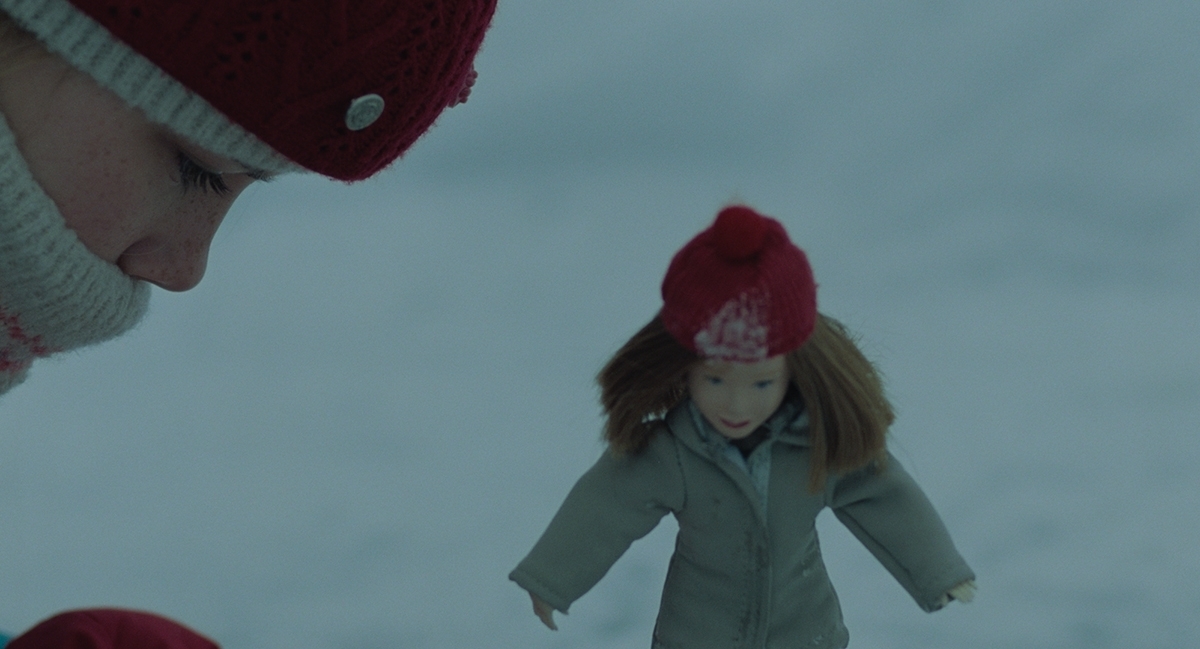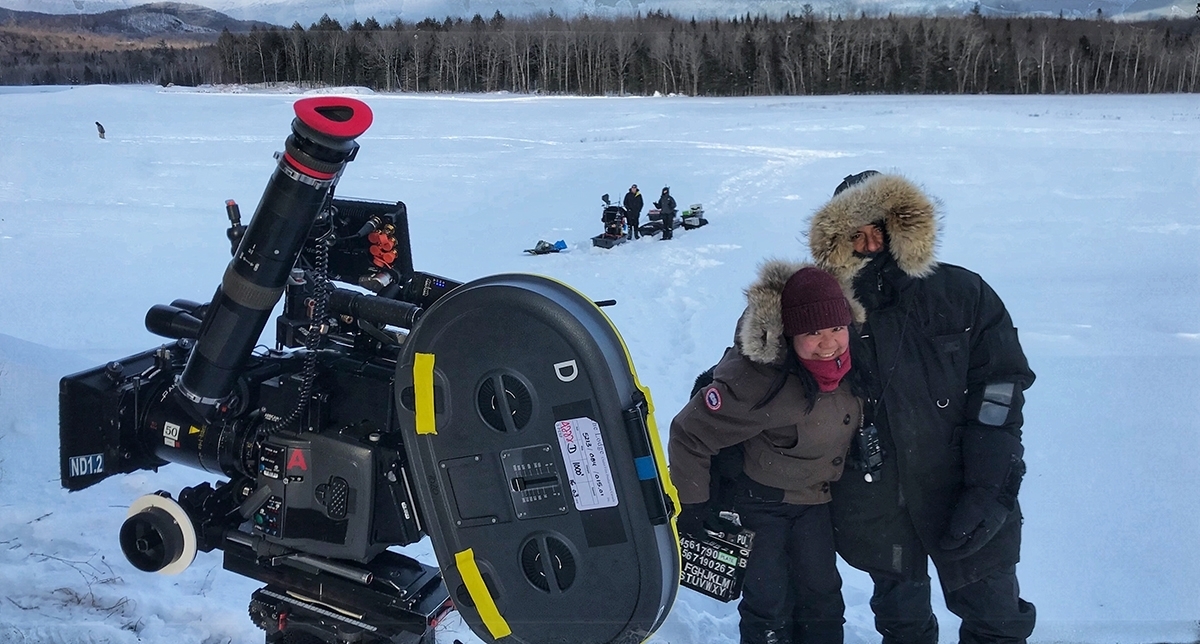DP Thimios Bakatakis paints nail-biting pictures for horror drama 'The Lodge' using Kodak 35mm film

A scene from "The Lodge," directed by Veronika Franz and Severin Fiala. © 2019 Lodge Distribution, LLC. All Rights Reserved. Photo by Thimios Bakatakis.
Captured on Kodak 35mm film and directed by Veronika Franz and Severin Fiala, the slow-burn, psychological horror movie, The Lodge, is a must-see for those seeking cinematic scariness. The movie’s haunting canvas was shot by the accomplished Greek cinematographer Thimios Bakatakis, who previously lensed Yorgos Lanthimos' acclaimed psychodrama The Killing of a Sacred Deer, also on 35mm film.
As the Austrian directing duo’s English-language follow-up to their unnerving and highly-acclaimed 35mm debut Goodnight Mommy (2014, DP Martin Gschlacht), The Lodge sees a small family unit trapped in a remote country house, where a sense of deep foreboding and dread hangs in the air.

A scene from "The Lodge," directed by Veronika Franz and Severin Fiala. © 2019 Lodge Distribution, LLC. All Rights Reserved. Photo by Thimios Bakatakis.
Author Richard (Richard Armitage) informs his wife (Alicia Silverstone) that he wants a divorce and announces to their children, Aiden (Jaeden Lieberher) and Mia (Lia McHugh), his plans to marry his new girlfriend Grace (Riley Keough), who recently absconded from an extreme evangelical death cult, which served as the subject of one of his books. The youngsters show little interest in their soon-to-be stepmother, although their father is eager to create an opportunity for them all to bond by spending a few days together over Christmas in a secluded winter cabin. Just as relations begin to thaw, a series of strange and frightening events take place.
The FilmNation Entertainment/Hammer Films production enjoyed positive reviews during its initial run on the festival circuit, applauded as a slice of intelligent but enjoyably malevolent storytelling.
With the help of production designer Sylvain Lemaitre, frighteningly frosty visuals of the cold white exteriors contrast with the daunting dark-wood lodge interiors to supporting the twisted proceedings. Bakatakis’ lens metamorphoses what initially appears to be a homely hideaway into a claustrophobic crucible of dread, with the rooms and hallways seeming to constrict as the events unfold. With religious symbols and motifs adorning every room, super-slow zooms and insidious tracking shots make it seem as if the camera itself were a menacing presence making its own way through the dwelling.

A scene from "The Lodge," directed by Veronika Franz and Severin Fiala. © 2019 Lodge Distribution, LLC. All Rights Reserved. Photo by Thimios Bakatakis.
Principle photography on the production, under Bakatakis’ supervision, took place over 35 shooting days from February to March 2018 in Harrington, Quebec and other locations in and around Montreal, Canada. The directors’ long-term love of celluloid meant that 35mm was a given from the very start of the project.
“We like every single aspect about shooting on celluloid better than when shooting digitally,” say directors Franz and Fiala. “Celluloid seems to be alive. We love the way it depicts light and darkness, the way it depicts fire and rain. The way it shows the human face. It's so hard to express but so easy to see and to feel.
“Of course, producers will always say that shooting on film is endlessly more expensive and difficult. That it's risky and that the advantages of shooting digitally are undeniable. But we haven't found any of this to be true. In both of our experiences with celluloid, the heightened concentration on set led to a very economical shooting style and costs weren't significantly higher than if we would have shot digitally.”

DP Thimios Bakatakis lining up a shot on "The Lodge," directed by Veronika Franz and Severin Fiala. © 2019 Lodge Distribution, LLC. All Rights Reserved.
Bakatakis says he had pleasure of meeting Franz and Fiala for the first time at the 2017 Cannes Film Festival, when Killing of a Sacred Deer was selected to compete for the Palme d'Or. “They described the story to me, and were eager to shoot The Lodge on film, as per all of their previous films. When we met again in Vienna to talk about the visualization of the script in greater detail, we discussed references and ideas about how the camera and the look could bring a creeping sense of dread to the story.
“Old horror movies from the 1930s, especially Vampyre (1932, dir. Carl Theodor Dreyer, DPs Rudolph Maté/Louis Née) helped to inspire the general atmosphere of the film but not the cinematography itself. My idea was to start the story with classic camerawork. But when the characters arrive at the lodge, the framing would become much more creepy and unsettling – using wide angles, plus super long lenses for close-ups, combined with smooth, ultra-slow movement, from either very low or high angles, on the dolly. As awful and detestable events unfold, the image would change again, with the recipe of colors becoming really cold, mirroring the chilling narrative.”

© 2019 Lodge Distribution, LLC. All Rights Reserved. Photo by Philipe Bosse.
Bakatakis selected a range of PANAVISION Ultra Speed and PANAVISION Primo lenses – between 10mm, 12mm and 17mm in focal length – for the wide angled shots, together with longer focal length lenses, typically in the 85mm to 150mm range, which would enable intimate close-ups.
“I used the Ultra Speeds when I wanted to encourage lens flares and the Primos when the picture needed more control,” he recalls.
Bakatakis says the aspect ratio of 1.85:1 was an important consideration in the framing of the film, as its shape allowed a gradual feeling of enclosure and claustrophobia on the slow dolly push-ins. The camera package and photochemical processing were provided by Mels in Montreal.

© 2019 Lodge Distribution, LLC. All Rights Reserved. Photo by Thimios Bakatakis.
After extensive testing of KODAK 35mm Daylight and Tungsten stocks, Bakatakis elected to shoot The Lodge using KODAK VISION3 200T Color Negative Film 5213 and VISION3 500T Color Negative Film 5219, citing his preference for their innate texture as key for this selection.
“Along with the creepy camerawork, the aesthetic quality of the images was really important in the emotional language of the film,” he explains. “In terms of general continuity, the 200T, which I used mainly for day exteriors, and the 500T, which I used for interiors and night sequences, make an ideal matching pair as regards their grain structures, depth of color and lovely rendition of skin and facial tones.
“But, these Tungsten filmstocks are both also incredibly versatile when it comes to exposure on set and processing treatments at the laboratory. I tested and really liked the results from a variety of exposures and different sorts of processing – push, normal and pull – on both stocks, with the idea of either increasing the contrast and grain in a particular scene or decreasing the contrast and bringing out details in the shadows.”

A scene from "The Lodge," directed by Veronika Franz and Severin Fiala. © 2019 Lodge Distribution, LLC. All Rights Reserved. Photo by Thimios Bakatakis.
He continues: “Of course half of action in the wooden lodge takes place after the electricity supply goes down. So my lighting sources had to come through the windows only, including daylight and moonlight. We wanted a naturalistic look, nothing artificial, and used HMIs with softboxes and frames outside the house to illuminate the interior scenes, and moved them far away, around 200m, during exterior sequences.
“Whatever the shot, it was remarkable how much detail the 200T contained in the black areas of the image when under-exposed by one or two stops and pull-processed at the lab. Sometimes, I would rate the 500T at 2000 ISO for an interior and be absolutely astounded by its ability to deliver details in super dark areas of the image as well as details through the window – that’s around 10-stops of difference in the same frame. You would be hard-pressed to get that same result if you shot digitally.”

DP Thimios Bakatakis and second camera assistant Soupharak Keoborakoth, beside the 35mm camera during production on "The Lodge," directed by Veronika Franz and Severin Fiala. © 2019 Lodge Distribution, LLC. All Rights Reserved.
While The Lodge delivers a tense and unsettling experience, Bakatakis says his participation in its making was quite the contrary. “I loved working with Veronika and Severin, the skillful and dedicated Canadian crew, and the talented cast, especially Riley Keough. We all had a good time working together I’m very happy having been able to shoot on celluloid once again and delighted by the final result. The texture of the grain film, and the different atmospheres you can evoke, makes the picture really engaging for the audience to watch, and would do it again gladly.”
For their part, Franz and Fiala believe the level of attention demanded from both cast and cast and crew on-set is, “one the aspects of shooting on film that we love most. Film production creates a certain atmosphere in which every aspect of everyone's work suddenly becomes much more important. Everyone - cast and crew - is more focused and concentrated; everyone knows that something great needs to happen right here, right now. It cannot be endlessly repeated and aimed for. With film, you don't just press a button and wait for the magic to accidentally happen. You press the button, hear the filmstock running through the camera, and everyone knows that magic has to be created the very same moment.
“Also, all the other things people usually tell you – that you need much more lighting, and it's much more difficult to shoot at night – haven't proven true and actually helped us to create the look of The Lodge. How celluloid reacts to available light and darkness has definitely shaped the way our movie looks. And we wouldn't want to re-shoot a single second of it digitally.”